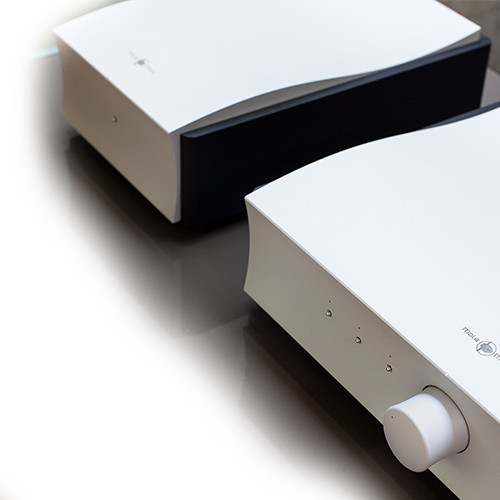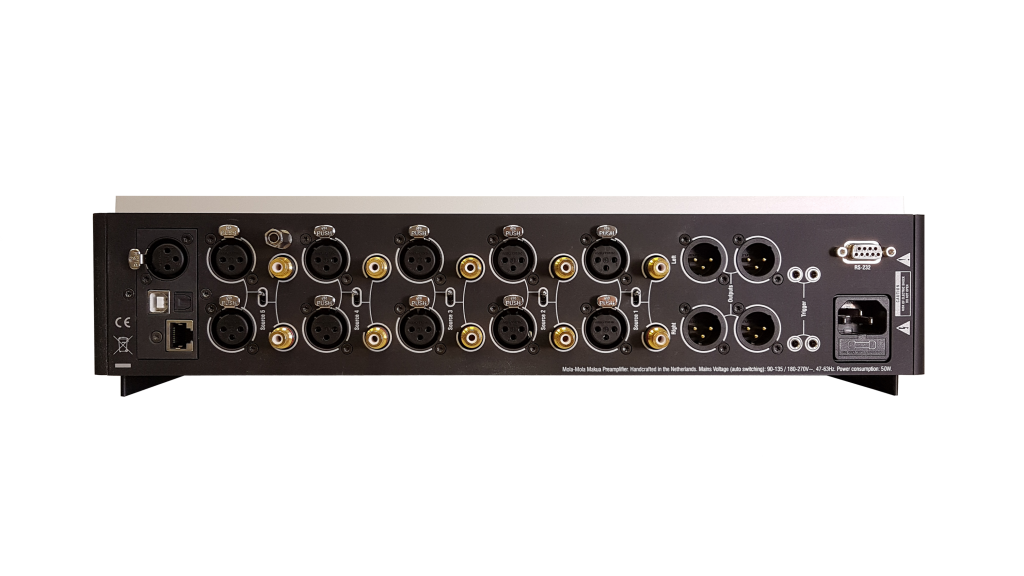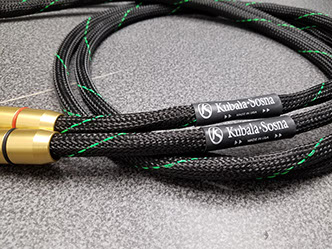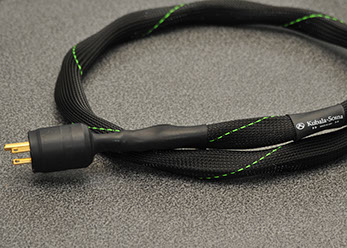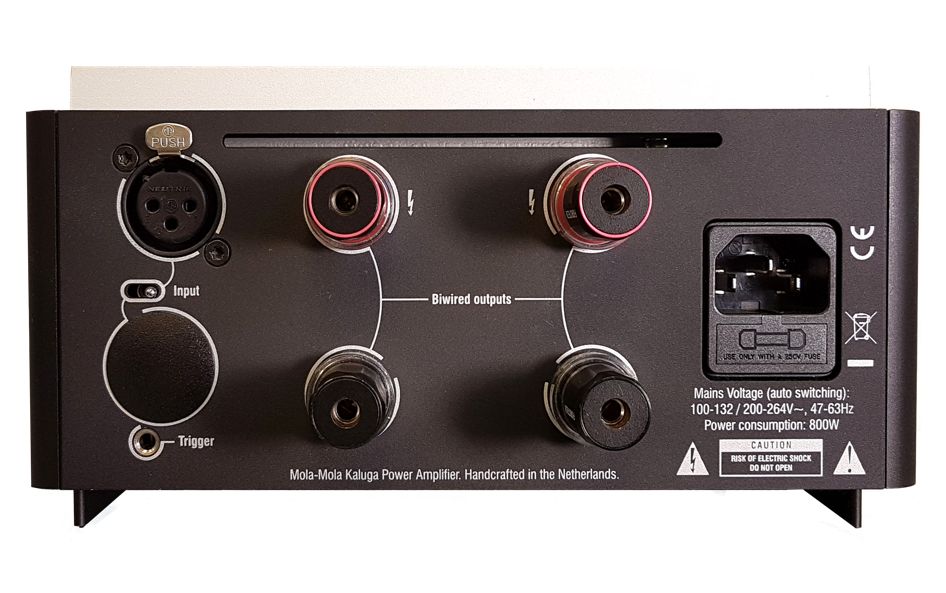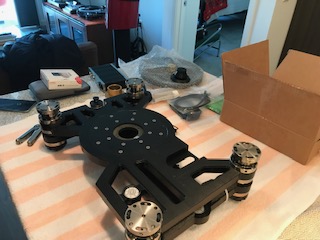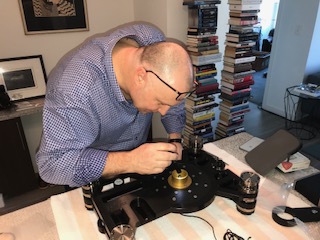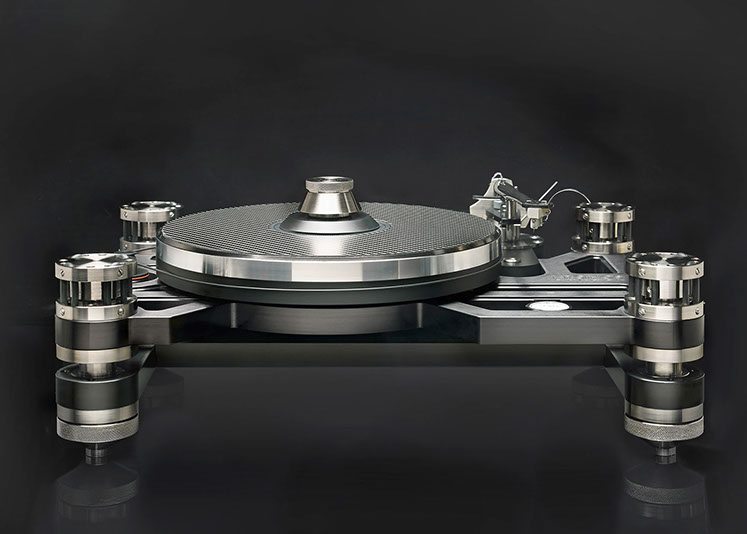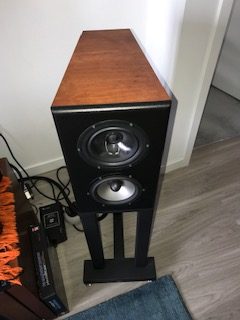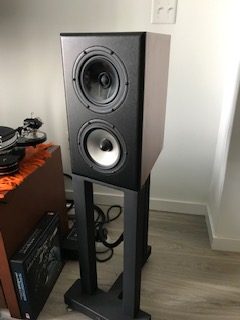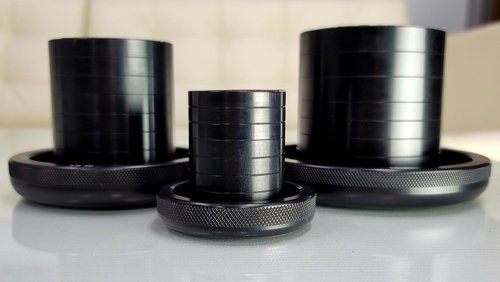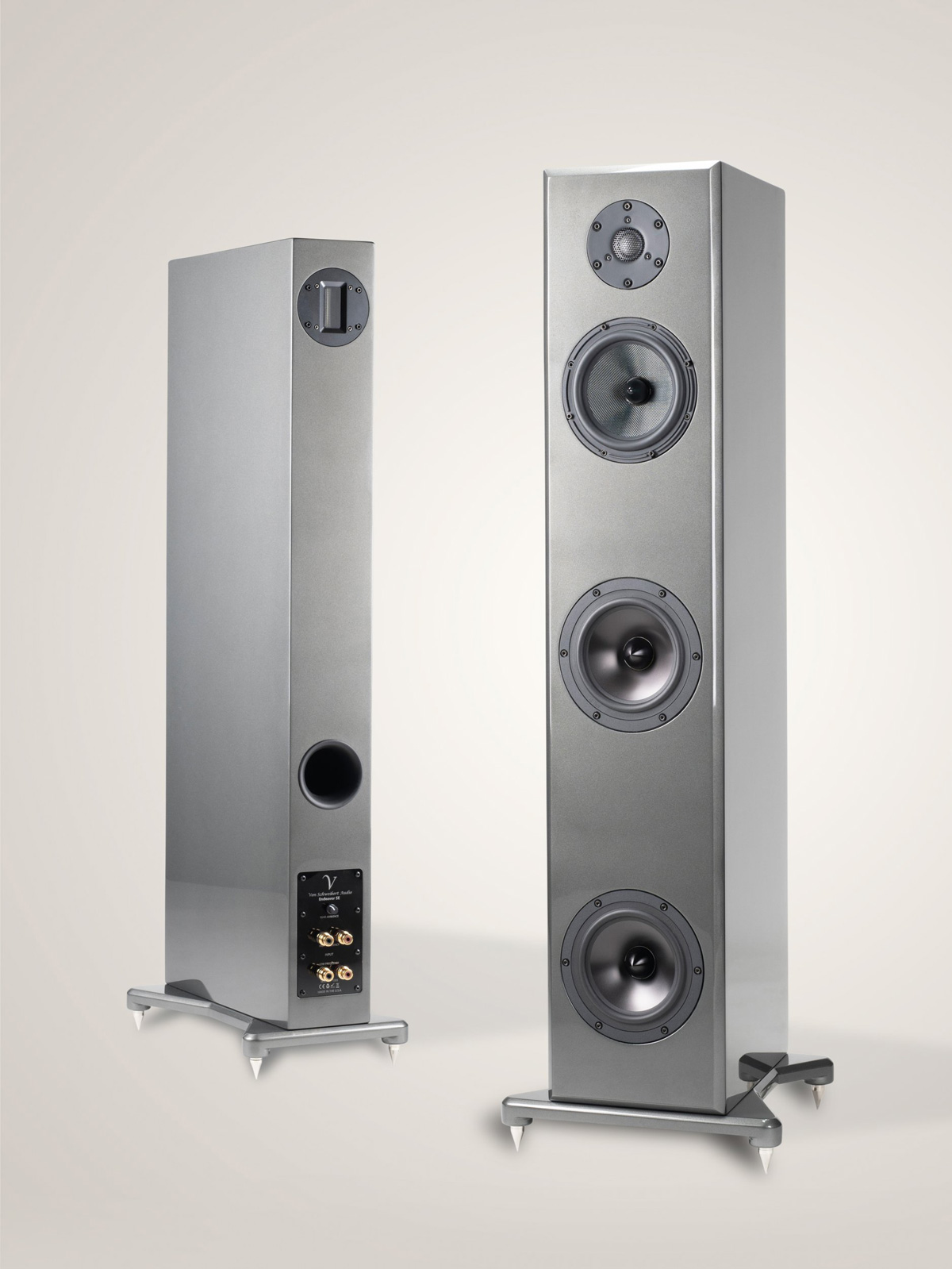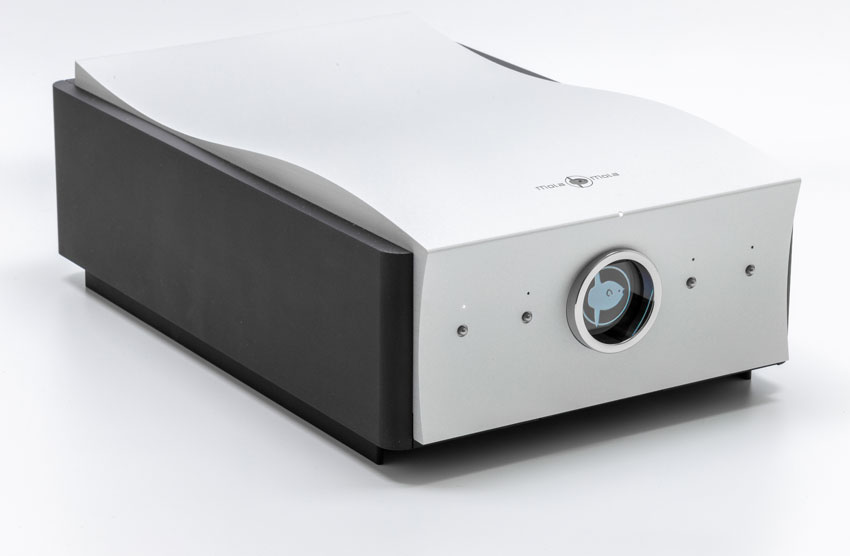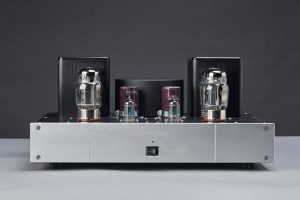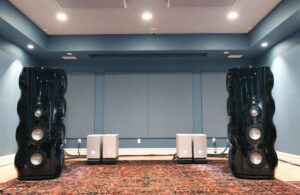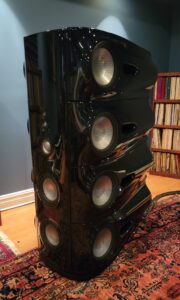In this installment of the New Apartment Lounge, Maurice Jeffries takes a long hard listen to the stunning Mola Mola amp/preamp suite, an almost affordable turntable from Kronos Audio, and some smooth-sounding new cables from Kubala-Sosna Research LLC. With a fresh set of ears and new insights, he also revisits an old and trusted friend.
Out of the Blue
Several months ago, I got a phone call out of the blue from none other than GTT Audio head Bill Parish. Bill called to apologize (profusely, I might add) for having shamelessly repossessed my beloved Audionet WATT Integrated Amplifier a year earlier. As an olive branch, he proposed offering me a replacement of sorts. If I toned down my one-man online war of words, Bill promised to deliver an amp / preamp combination that would make me forget all about my long-lost WATT integrated. Skeptical at first, I slowly warmed to the idea (at least in my head) when Bill revealed the identity of the mystery electronics: the highly regarded Mola Mola Kaluga proprietary Class D mono amplifiers, and the companion Makua full-function preamplifier (meaning line stage plus fully customizable onboard DAC and phono stage. When our own Marshall Nack reviewed the Mola Mola suite back in 2016, HERE, he deliberately chose not to evaluate the DAC or phono stage, better to minimize sonic variables during the review process.)
Not wanting to seem unreasonable, I conceded that Bill's peace offering certainly sounded intriguing. Perhaps sensing my lingering reticence, Mr. Parish offered to sweeten the deal by arranging for me to audition the Mola Mola gear with a complete loom of the stellar new Kubala-Sosna Sensation cables (meaning interconnects, power, digital, and speaker cables) and maybe even a source component. This was more like it! If you want to bribe the Big Dog, Bill, you'd better bring more to the table than some glitzy electronics.
Not long afterwards, the Makua/Kaluga combo arrived chez Jeffries, packed in lovely foam-lined flight cases, and accompanied by a comprehensive instruction booklet explaining setup intricacies, and a cute, if minimal, remote (a pricier remote console that matches the aesthetics of the amps and preamp is available for an upcharge). Tipping the scales at a svelte 15 lbs per mono block, and a beefier but hardly backbreaking 24 lbs for the preamp, each component in the Mola Mola stack feels as solid and substantial as a brick. However, their manageable size (half-width for the amps, full width for the preamp) and weight make them as easy to place and maneuver in my audio rack as any components I have come across.
Seeing and touching the Makua/Kaluga gear for the first time leaves an indelible tactile impression. Utterly minimalist in form, the Makua preamp and Kaluga Class D mono amps surely rank amongst the most gorgeous high-end components to hit the market in recent years. The elegantly swooping micro bead-blasted aluminum chassis evokes ocean waves, a subtly witty design reference to the ocean-dwelling species of sunfish from which the company takes its name. In an apparent nod to vintage design, the sculpted black side-panels that adorn the amps and preamp evoke the wood side panels that appeared on virtually every mid-fi receiver and tuner from the 1970s. Here, the panels serve to break up what would almost certainly come across visually as a slightly monotonous swoop of silver micro bead-blasted aluminum, the black slabs smartly and elegantly contrasting with the stark silver sheen of the main chassis.
Ergonomically, the Mola Mola suite eschews minimalism in favor of near total user control over all core operating features via an extremely well-executed app. Simply download the Mola Mola app to your preferred tablet or laptop, register the preamp, and you're ready to go. Day in and day out I found the units and the associated control app an absolute joy to use. The app allows users to configure the Makua's six inputs in numerous ways. For example, one can configure each of the six as a dedicated phono input, assuming one has enough table / arm combinations in house to take advantage of this arrangement. Typically, and this is how I used the Makua, users will utilize inputs 1-4 for digital disc players, tuners, and the like, input 5 as the dedicated phono stage, and input 6 as the preamp's high performing DAC. The DAC boasts an ethernet / LAN connection that permits quick preamp / DAC / phono stage software updates, as well as AES/EBU, USB, and optical inputs.
Quoting directly from the Makua "long read" product description page, the "6 preset buttons are programmable via USB or Bluetooth to access any combination of channel, processing and routing. In a system with mainly digital sources, the preset buttons would be programmed to select between them. Vinyl lovers on the other hand might want to use several buttons to select the same turntable but with different EQ settings to suit their large collection of historic LP's (sic). All five inputs are switchable between XLR and floating RCA connections, and all can be assigned as either phono or line. All stages in the Makua use discrete amplifier modules in a little-known topology called 'single-ended driven differential.' Compared to doubly executed signal paths, this structure prevents noise from propagating all the way through."
In case you didn't know, the driving creative force behind the Mola Mola brand is none other than audio engineer extraordinaire Bruno Putzeys, creator of the celebrated Universal Class D (UcD) amplifier module and, more recently, the widely praised N-Core Class D amplifier module, both for Hypex. Brands as toney as MBL, Rowland, and Theta, as well as down to earth players like NAD, all use the N-Core Class D amplifier module in their product lines, a testament both to the design's incredible adaptability and inherent good sound (not to mention outstanding measured performance). Bruno also designed the Makua onboard DAC and phono stages, both revolutionary products in my estimation.
A few days after the MM suite arrived, a hefty plastic shipping case containing the Kubala-Sosna Sensation cable loom magically appeared at my doorstep. After some twisting, contorting (of my back), and more than a bit of cursing, I finally coaxed all the new cables into place. The only connection challenge I encountered occurred between the power amps and KS power cables. Simply stated, because of their light weight (15 lbs per side), the amps are quite prone to shifting position when one tries to attach beefy audiophile-grade power and speaker cables. Frequently, this results in the power cable coming undone entirely. Compounding things, the power cord receptacle itself is not quite deep enough to permit an ideally secure connection between cable and amp, meaning that any pressure exerted on the amp chassis risks dislodging the power cord(s) from the amplifier power input terminal.
Given that their light weight stands out as one of the power amp's key charms, I would love to see MM increase the depth of the power cable receptacles, better to accommodate the beefy after-market power cables that many audiophiles favor. This minor quirk aside, set-up of the entire system proved largely trouble free and uneventful. Finally, I was ready to go!
Into to the Clear
Like many audiophiles, I admittedly brought a few biases and prejudices against Class D operation to the table before I even heard what the Mola Mola suite, particularly the amps, could deliver sonically. At a couple of past audio shows, I deliberately avoided rooms featuring Class D amps because, pretty faces notwithstanding, how could any Class D unit, no matter how novel the design, offer sound quality in any way competitive with the best linear power amps? It wasn't until my close friend Greg Weaver (that clown again?) raved about the Dutch-sourced amplifiers in a series of totally unrelated phone calls that I even began to consider giving the Mola Mola products a listen.
Now quite curious, I expectantly suggested to Bill that he let me play with the Makua and Kaluga separates instead of a much larger (and heavier) set of amps that I had been considering. The fact that the MM amps and preamp are both of reasonable size and weight only strengthened the argument for why they were a shoe-in review candidates for my New Apartment Lounge column.
Preconceptions aside, I was left in utter disbelief at what the Mola Mola / Kubala-Sosna pairing delivered sonically, with a little help from the lovely AURALiC ARIES G1 wireless streaming transporter that I reviewed back in April (HERE), and later, from the simply stunning Kronos Sparta 0.5 turntable. Instead of the gray, sterile, bass-heavy presentation that I have encountered with earlier Class D amps, the MM / KS combination laid bare (but never antiseptically so) the intricate tonal shadings and delicate interplay of timbres and textures that make Polish trumpeter Tomaz Stanko's 1999 release From the Green Hill (ECM) so musically compelling. By the same token, master tape-to-DSD transfers like Falla's Three Cornered Hat (London/DSD) sounded reassuringly warm, airy, and holographically three-dimensional, what one would expect playing the original London LP release of the same work on a reference-grade analogue rig, but with all of the recording's inherent glow and beauty retained by the Dutch / American partnership.
Great vocal recordings proved equally compelling. I recently spent an entire evening streaming digital files from my newly acquired Qobuz hi-res account to the AURALiC ARIES G1 digital transport. I fed the G1 digital signal to the Makua onboard DAC using a meter of Kubala-Sosna Sensation USB cable. Feeling a bit blue after the recent death of my father, I sought comfort in the soothing embrace of Frank Sinatra's always reassuring baritone. I can't say that I have ever heard the handful of vintage Sinatra recordings I pored over sound as faithfully, or convincingly authentic and moving as I experienced via the G1 transport / Makua DAC pairing.
Capitol warhorses like 1953's Songs for Young Lovers (Capital), streamed at 24-bit / 192kHz resolution, or In the Wee Small Hours (Capitol) from 1955, also available as a 24-bit / 192kHz file, sounded as sweet, lyrical, and moody as I expected, but with nary a trace of added sepia-toned color to cloy the sonic picture. The MM / KS suite captured intact every generational shift in Francis Edward's iconic baritone, from the "almost but not quite" low-tenor airiness of the early 1950s, to the honey-and-scotch perfumed, full-on baritone glow of his mature period, leaving at the alter only that last bit of saturated tone and timbre (especially compared to the 6 times as costly VAC Statement 450i iQ integrated amplifier that I raved about HERE). As icing on the musical cake, the MM / KS suite displayed a level of virtual 3D palpability that, along with near class-leading air and texture, sounded positively otherworldly.
Into the Wax
As enthralling as digital files and CDs sounded through the GTT Audio-sourced system (with special kudos to the reference-level onboard Makua DAC), the Kronos Sparta 0.5-fronted vinyl playback setup literally knocked me for a loop. But, first a bit of narrative background. Bill and I had originally planned for my review of the "entry-level" Kronos turntable to begin later this year.
As fate would have it, a series of analogue front-end mishaps at the Lounge, highlighted by the death of my SME M2-9 tonearm cable, and the equally unexpected death of the motor to my beloved Thorens TD-125 Mk. II turntable (all reported by me HERE) meant that I needed to get my hands on some replacement analogue gear fast. Not long after, Bill arrived to set up the Sparta 0.5, a detailed and exacting process best left to your dealer, as the pictures that accompany this piece make clear.
The 0.5, like its bigger brothers the full-blown Sparta and the range-topping Kronos Pro, is a sui generis animal that ingeniously weds mass loading design techniques to the long-recognized benefits of suspended turntable isolation. Fully assembled, the Kronos speaks visually with the same "I kick ass" bravado and "ain't I pretty to look at" design swagger as a top-model Ferrari, or the stunning Corvette ZR1 (if over-the-top domestic muscle cars strike your fancy—they do mine). From the beautifully textured finish of the cut-away black aluminum plinth, to the sophisticated engineering of the constrained layer-damped platter, to the novel support pillar/footer towers that cannily and stealthily hide the novel rubber wire-tuned suspension mechanics, the 0.5 is all business.
Despite the absence of Kronos's signature counter-rotating second platter (a $7,500 upgrade over the 0.5's $15,000 base price, sans tonearm) and supporting plinth assembly, the Sparta 0.5 remains a two-level concoction. Look closely and you'll notice that the lower level of the plinth employs the rigid, non-vibrating, mass loaded design strategy that has become commonplace in the high end. Constructed of the same textured black aluminum as used to construct the cut-away upper plinth (suspended), the lower plinth assembly (unsuspended, and which appears to the eye as a monolithic aluminum slab that resembles the letter "I") essentially functions as a support foundation for the suspended upper levels (meaning, again, the cut-away upper plinth, the platter and platter bearing assembly, and arm board/tonearm assembly).
Sonically, a topic about which I will have considerably more to say in my full review of this exceptional product in the early fall, the 0.5 delivers superb rotational stability, consistency, and composure, depth-charge like dynamic expressiveness, and near master-tape level continuousness and flow, the latter an area where I feel that the best vinyl playback systems still reign supreme when compared to the best digital sources (although I freely admit that the performance gap between the two camps continues to shrink at an alarming rate).
From the Kronos website
Bear in mind that I obtained the terrific results described in the paragraphs above and below courtesy of a "humble" Jelco TK-950S 9-inch tonearm, my tried and true Zu Audio / Denon low output MC cartridge, DIN-to-RCA phono cabling from Canada-based Audio Sensibility, and the remarkable Makua onboard phono stage. I did not have on hand, nor will I for the foreseeable future, the Kronos Helena 10.5" arm, the manufacturer's recommended partner for the 0.5 and full-blown Sparta turntables. Why? Simply stated, I first want to explore what the 0.5 is capable of sonically when paired with real-world (and sanely priced) supporting products. Indeed, it was none other than Mr. Parish who suggested the Jelco / Sparta 0.5 pairing to me, one he recommends to audiophiles ready to enter the Kronos universe, but who lack the coin to secure the matching Helena arm.
Without spilling some (or all) of the musical beans, and with the central caveat that the Sparta 0.5 / Jelco / Zu Denon combo will not deliver all of the slam, sparkle, speed, and life of a Sparta 0.5 / Helena partnership—along with an appropriately chosen top-flight phono cartridge—let me just say that whether recreating the momentum, force, and drive of John Coltrane's recently unearthed Both Directions at Once (Impulse) LP, the languid musings of pianist Bill Evans, or the infectious lyricism, wry wit, and boundless harmonic ingenuity of tenor saxophonist Stan Getz unpacking Luiz Eca's evocative The Dolphin from Getz's 1981 Concord Jazz release of the same name, the Sparta 0.5/Jelco/Zu Denon combo never failed to impress.
Superbly colorful, infectiously dynamic, and remarkably balanced overall, these analogue overachievers do just what I want from a sensibly priced (in high-end terms, of course) vinyl setup: they get on with the business of making music in the most engaging and involving of ways, with nary a hiccup, bump, or wrong-foot put forward. If my short time with the 0.5 is any indication, Kronos may just have in its growing lineup of products one of the finest sub-$20K turntables available anywhere.
The Shape of Things to Come
I'd be more than a little remiss in my duties as an audio reviewer if I failed to acknowledge the contributions of another component (two, actually) that has made it possible for me to appreciate in starkly revealing terms just what the creative folks at Kubala-Sosna, Mola Mola, Kronos, and Jelco have accomplished with their latest inventions. The Von Schweikert Unifield 2 Mk III speakers, substantial compacts that have anchored my reference system for the last year and a half, have, in the words of the Sorcerer Supreme, elevated my reference system "to heretofore unimaginable heights," demonstrating resoundingly that great speakers have the capacity to scale up or down performance-wise depending on the quality of the electronics and sources used to drive them.
In my formal review of the Unifield 2 Mk. IIIs (HERE), I praised the speaker's exemplary low frequency extension, remarkable linearity, and class-leading pitch and textural precision. At the same time, although taken by the 2's laser-sharp image focus and near holographic sound staging, I came down a bit hard on what I felt were the speaker's tendency to present music with a slightly analytical tilt, and its (perceived) less than class-leading scaling and stage height recreation. As it turns out, in both instances I couldn't have been more mistaken.
Hearing the VSA speakers driven first by the remarkable Audionet WATT Integrated Amp, and now by the superbly transparent Mola Mola suite, I quickly realized that the mildly analytical presentation and soundstage-related colorations that I originally ascribed to the speakers were in fact colorations that I should have directed at my then reference electronics. Simply stated, all the things I loved (and love) about the 2s were amplified by the WATT and Mola Mola front ends. At the same time, the soundstage height, scaling, and tonal balance anomalies that mildly irked me when I drove the 2s with lesser gear simply became non-issues when I inserted pricier, but more importantly, genuinely neutral (re: natural) sounding amps into the system.
The takeaway here is that the 2, perhaps more than other speakers in its price class, only gives its best when powered by very good associated gear. As much as any component I have used (the exception being the stellar VSA ULTRA 9s, speakers that may be even more demanding of really good upstream sources and amps), the 2 simply must be driven by quality associated electronics and sources if the user is to get what s/he paid for in musical terms. In practical terms, this means that the music lover who expects to get great sound from the 2 using an otherwise solid performing $3K integrated amp is likely to come away a bit disappointed with what s/he hears at the end of the day.
In this regard, the Unifield 2 is as neutrally balanced a small speaker as I have heard, meaning that its innate sound largely (but not entirely) depends on the inherent sound and tonal proclivities of the upstream components paired with it (along with the room where it is placed) instead of the speaker itself. Although my experience with VSA products does not run as deep as, say, Greg Weaver's, someone who has followed the progression of the VSA house sound for almost twenty years, I think that the basic sonic traits I described above more or less apply to the entire line. This was certainly the case when I got to hear the miraculous ULTRA 9s earlier this year at Greg's house. During my roughly 20-hour fling with the 9s, it became crystal clear that they sounded more lifelike, more dynamic, and more coherent when driven by the VAC Statement 450i iQ integrated amplifier as opposed to the very fine but not quite reference-level Constellation Inspiration amplifiers that Greg had on hand. Like the 2, the 9's performance scaled up or down depending on the overall quality of what we chose to drive the speaker with.
I'll have more to say about the remarkable synergy between the Mola Mola suite and the Unifield 2 in my upcoming reviews. For the nonce, I can't imagine listeners confined to tight quarters not being totally enamored with the 2's ability to draw out the Kubala-Sosna Sensation loom's eerie quietude, center of the earth bass reach, blinding transient precision, marmoreal dynamic clout, and class-leading tone and timbral precision; the Mola Mola amp's remarkable purity, transparency, and openness; or the Kronos Sparta 0.5 / Jelco / Zu Denon combo's uncanny sense of forward momentum and drive.
The speaker is just that good (and now officially my primary reference)! Then again, so too is just about everything else in the system just that damn good. These are absolute "when my boat comes in" / get off the high-end merry-go-round products, each designed with passion and zeal, and real contenders for space-starved music lovers who want the very best and are willing to pay to get it.
Cheers!
Mola Mola Makua Preamplifier with onboard DAC and Phono Stage
Retail: Line stage $12,200; Phono stage $3000; DAC $8200
Mola Mola Kaluga Class D Mono Power Amplifiers
Retail: $17,200/pair
https://www.mola-mola.nl/index.php
Kronos Sparta 0.5 Turntable
Retail: $15,000
U.S. Distributor for Mola Mola and Kronos Audio
GTT Audio & Video
356 Naughright Rd.
Long Valley, NJ, 07853
USA
908.850.3092
Jelco TK-950S 9-inch Tonearm
Retail: $1259
Signature Silver Angle DIN to RCA Phono Cable
Retail: $800 (USD)
Source
Audio Sensibility
3 Mylesview Place
Toronto, Ontario
Canada M2N 2M7
416.953.8898
Kubala-Sosna Research LLC Sensation Cables
RCA and XLR interconnects: $5800m/$1200 each additional meter
Speaker cables: $5800m/$1200 each additional meter
Digital cable (USB): $2200m/$600 each additional meter
Power cords: $1650m/$400 each additional meter
Kubala-Sosna Research LLC
11 Melanie Lane, Unit 24A
East Hanover, NJ 07936




